- 1. Functions of the kitchen island
- 2. Pros and Cons of Kitchen Island Layout
- 3. Varieties of Kitchen Layouts with an Island
-
4.
Stylistic Interior Solutions
- 4.1. Kitchen with Island in Classic Style
- 4.2. Contemporary Style Kitchen with Island
- 4.3. Provence Style Kitchen with Island
- 4.4. Country Style Kitchen with Island
- 4.5. Loft Style Kitchen with Island
- 4.6. Modern-Style Kitchen with an Island
- 4.7. Provence-Style Kitchen with an Island
- 4.8. Country-Style Kitchen with an Island
- 4.9. Loft-Style Kitchen with an Island
- 5. Small Kitchen with an Island: Interior Design
- 6. Kitchen with an Island – Photos
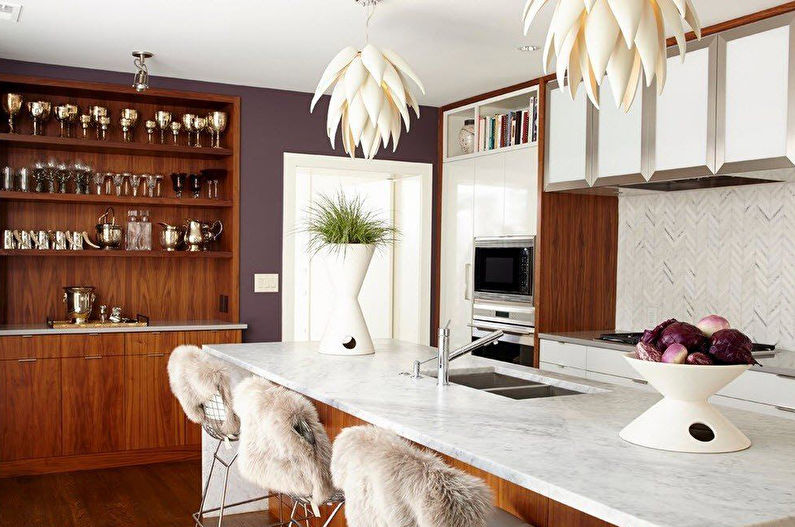
Organizing the kitchen space is one of the basic tasks when choosing a design for this room. In particular, layout planning needs a lot of attention. Convenient furniture and appliance placement will ensure comfortable cooking conditions, food intake, and simple home leisure time. From an ergonomic perspective, the best option for spacious rooms is a kitchen with an island, i.e. a tall cabinet countertop, which is most often set in the center and can perform many functions. Such a scheme is commonly seen in country houses, elite studios, restaurants, but if desired, it can be adapted and applied even in ordinary small apartments.
Functions of the kitchen island
Depending on its design, a kitchen island can serve many purposes. Sometimes it even acts as one of the vertices of the so-called “working triangle,” which includes the stove, sink, and refrigerator. However, installing these elements in the center of the room requires special connection of utilities, which is not always possible, especially in multi-storey buildings.
As a rule, the island is used as a countertop – its height makes it easy to work while standing. In addition, it can either completely or partially replace the dining area. To fit chairs around it, the cabinet should be without side panels. The island feature is often styled as a bar counter, which allows to save kitchen square feet (square meters) and visually demarcate the space.
Many hostesses use the free space under the island table for storing dishes, small appliances, groceries. If necessary, an oven, dishwasher, or freezer can be built into the cabinet.
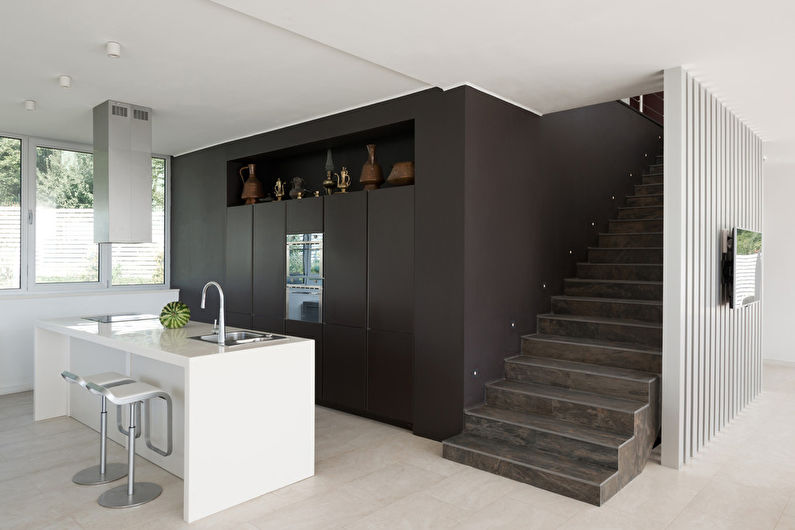
Pros and Cons of Kitchen Island Layout
A tall table in the center of the kitchen is, undoubtedly, very convenient. Such a layout is ideal for cooking together, as access to the work surface is available from all sides. While performing tasks, the hostess can converse with household members or guests without turning her back to them. Moreover, compared to other types of layouts, the trajectory of movements is significantly reduced, which in turn reduces the physical effort required to prepare dishes.
The presence of an island helps to fill the space of a large kitchen, but it can be challenging to accommodate this piece of interior in small rooms. In any case, at least one yard (one meter) should be left around the standalone cabinet on all sides for comfortable movement. For a compact cooking area, it’s better to choose narrow mobile or foldable structures instead of monumental tables.
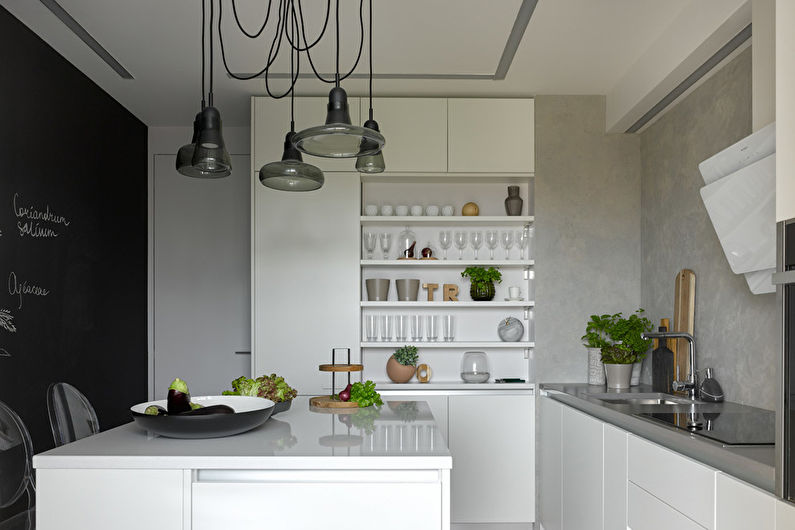
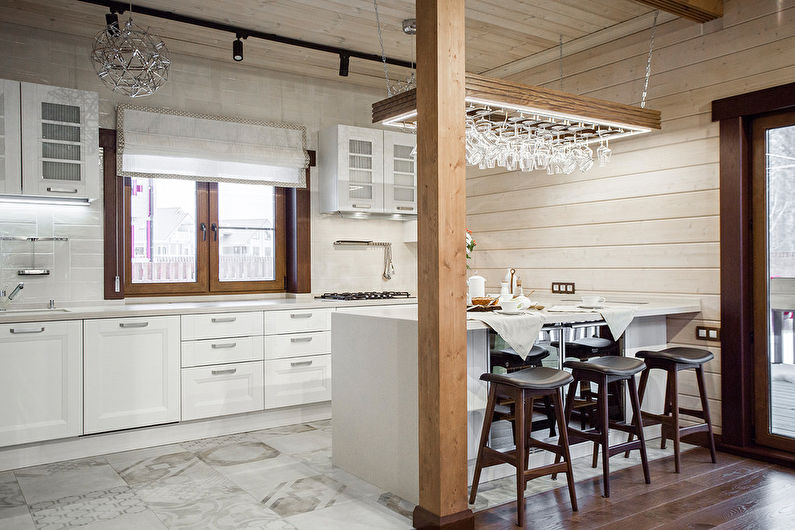
Varieties of Kitchen Layouts with an Island
When mentioning an island, most people picture hefty, bulky cabinets in the middle of a luxurious 65-foot kitchen in a private house. Of course, this is a classic option for cottages, but modern design accommodates other types of such furniture. Thus, an island table doesn’t necessarily have to be rectangular or square – oval, semicircular, smoothly curved, zigzag, triangular shapes are all possible.
Multilevel structures, also referred to as archipelagos, are currently in fashion. The varied countertop heights allow for comfortable standing work on one side and seating for breakfast or dinner on the other. Sometimes the lower part of the archipelago can be adapted for a sink or a stove, and the higher part in this case is used as a kitchen work table or a bar counter.
Another variant of island layout is a peninsula. This type of table is distinct in that one of its sides adjoins the kitchen set, wall, or windowsill. This is a clever way of saving space in a small kitchen, wherein the protruding detail remains a harmonious part of the whole ensemble without losing its functionality.
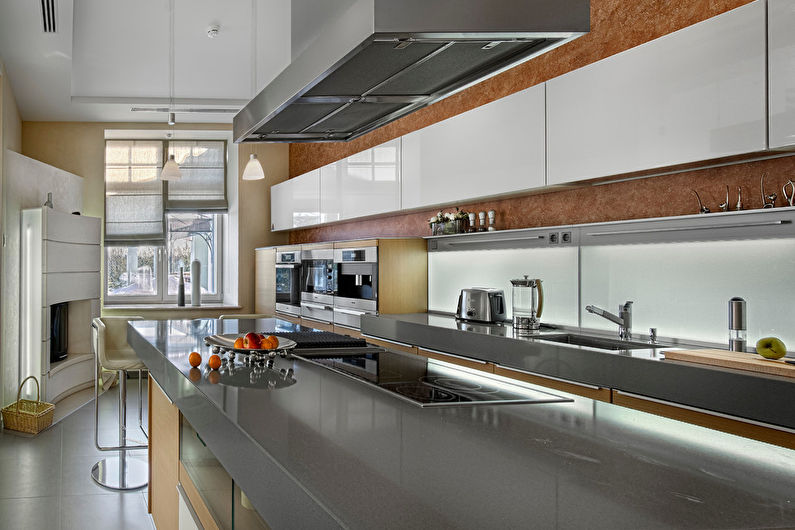
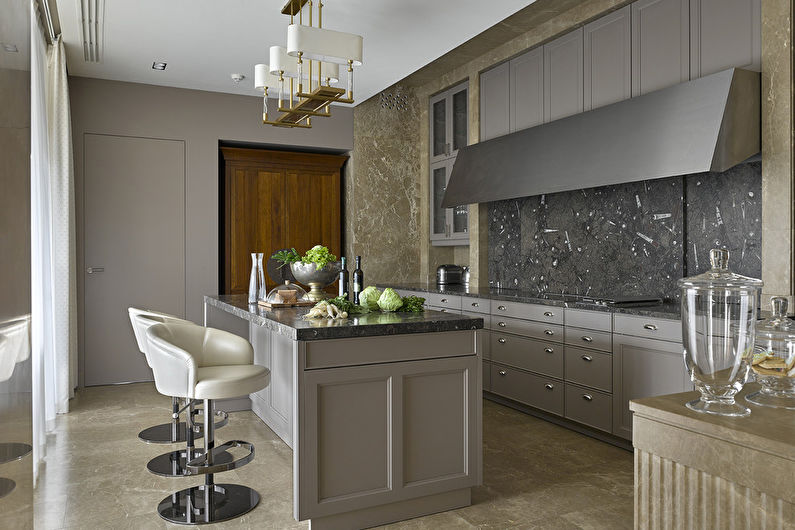
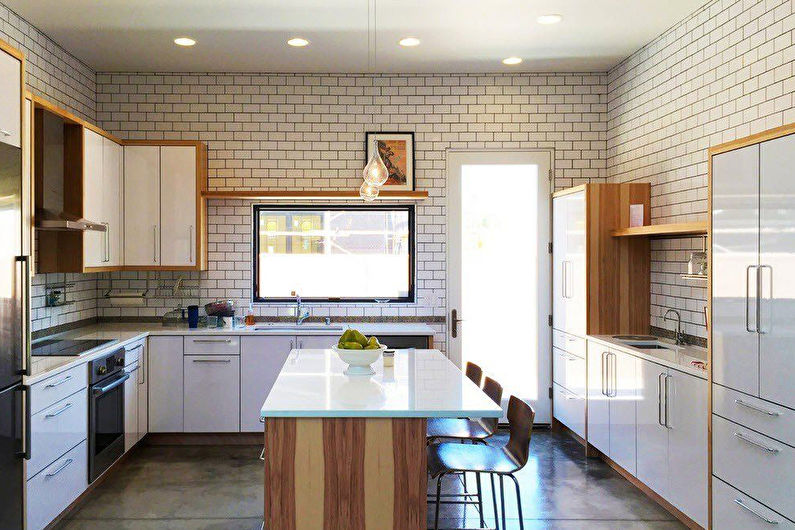

Stylistic Interior Solutions
Most of the time, people aim to match the island to the tone of the kitchen set and the overall kitchen decor. Repetitive color scheme, materials, and decor look thoughtful and appropriate, which is particularly important for small spaces. If the cooking area is spacious, you can make this piece of furniture the highlight through a brighter color or original texture. In any case, the island cabinet, being one of the most noticeable details in the kitchen interior, should correspond to the chosen design direction.
Kitchen with Island in Classic Style
You can find successful examples of a kitchen with an island in a classic style in the collections of Italian furniture salons. Typically, these are exquisite combinations of polished hardwood and light ivory enamel with decorative gold plating, fillets, columns, baroque carved decorations. Also possible are black and white, black and gray, olive, pinkish options with silver fittings.
The countertop of the island in the classic style can be wooden or marble, with a noble glossy pattern. The cabinet should be exclusively stationary, large and sturdy, rectangular in shape with symmetrically rounded corners. Above it, you can hang either an extractor hood (for a stove) or a beautiful crystal chandelier.
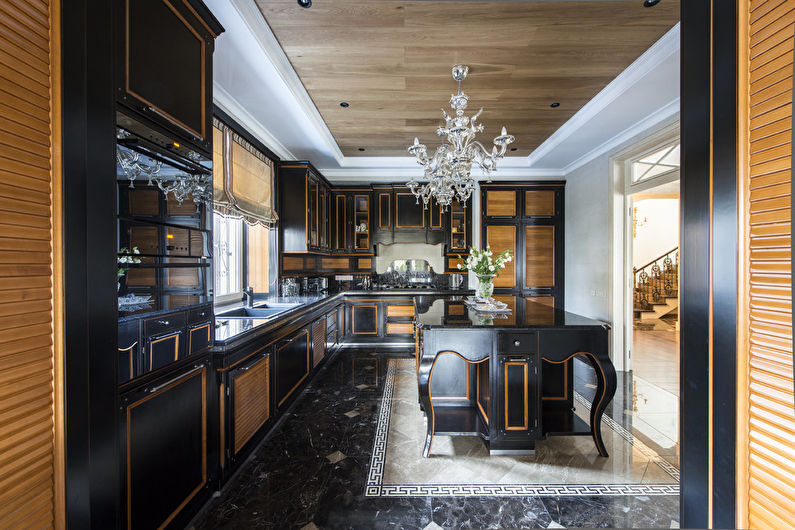
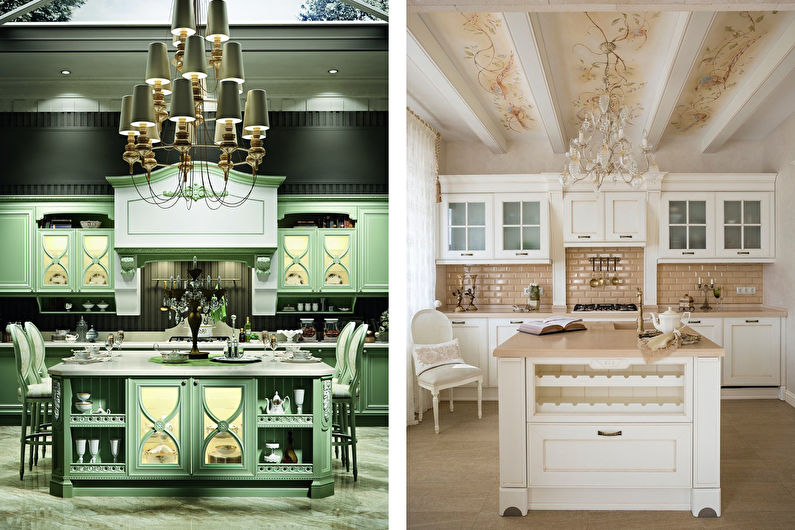
Contemporary Style Kitchen with Island
The defining characteristics of a 21st-century kitchen are minimalism, functionality, and high-end technology, all aimed at speeding up the cooking process as much as possible. In such an interior, an island forms an integral part of the kitchen set, almost completely mirroring its design.
The smooth, solid-colored countertop is made of a durable composite material – artificial stone, tempered tinted glass, stainless steel. It can house an induction hob, a sink, while the cabinet is used for appliances or spacious storage systems.
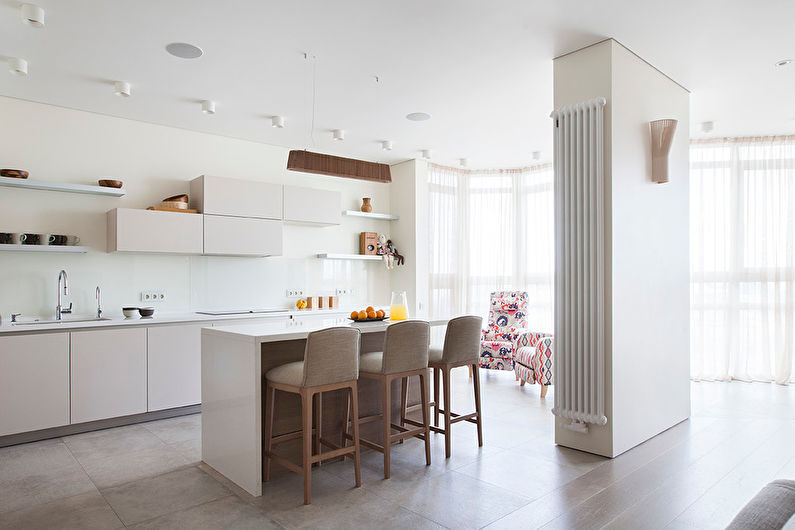
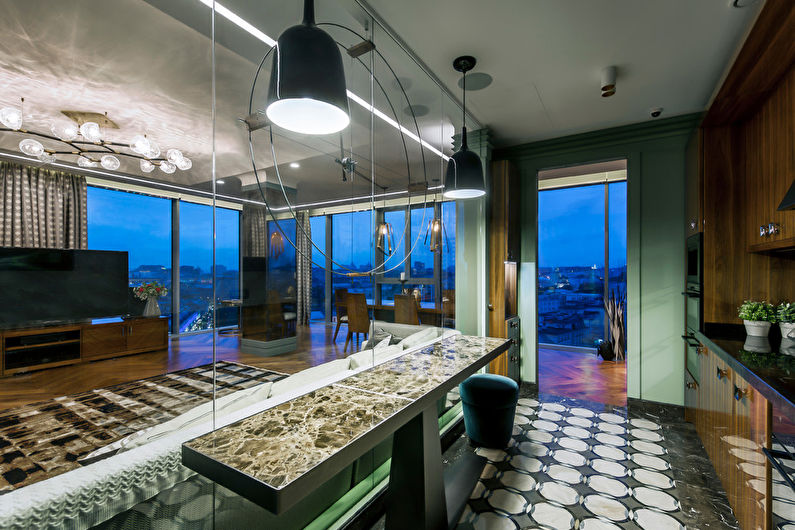
Provence Style Kitchen with Island
An island in a Provence style kitchen fits perfectly. Traditionally, it’s a simple wooden structure, painted in pastel shades. The color palette includes milky white, mint, turquoise, grey, blue, lavender. The design is unpretentious and lacks excess decoration, but its functionality comes from an abundance of cupboards, pull-out drawers, shelves, wicker baskets.
Given that Southeast France is a wine-growing region, the local kitchen island often includes diagonal honeycomb shelves for horizontal wine bottle storage. The countertop material in the Provence style is light stone, marble, or its artificial counterparts in white or greyish tones, but it should not be overly glossy.
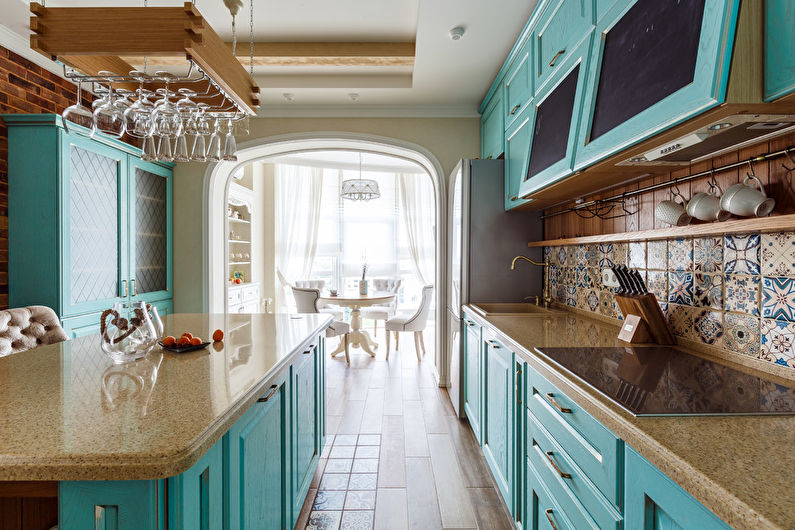
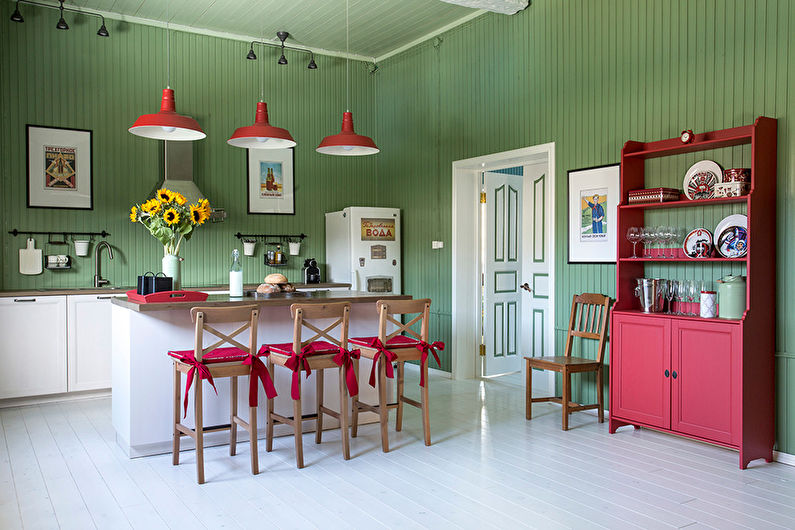
Country Style Kitchen with Island
Rustic style primarily relies on natural materials and earthy tones. A robust, slightly coarse cabinet made of solid wood, with large fronts of cupboards and drawers for dishware storage, will fit well into this setting. Ideally, the material should lack any coverings, except perhaps a protective layer of varnish or beeswax. You can artificially age new furniture pieces, giving them a medieval appearance.
Forged fittings should be used, as they serve as the main ornamentation and a crucial stylistic element in a country-style interior. As for the countertop, it can be of the same wood, unpolished stone, or clad in matte ceramic tiles (porcelain stoneware) of terracotta shades.

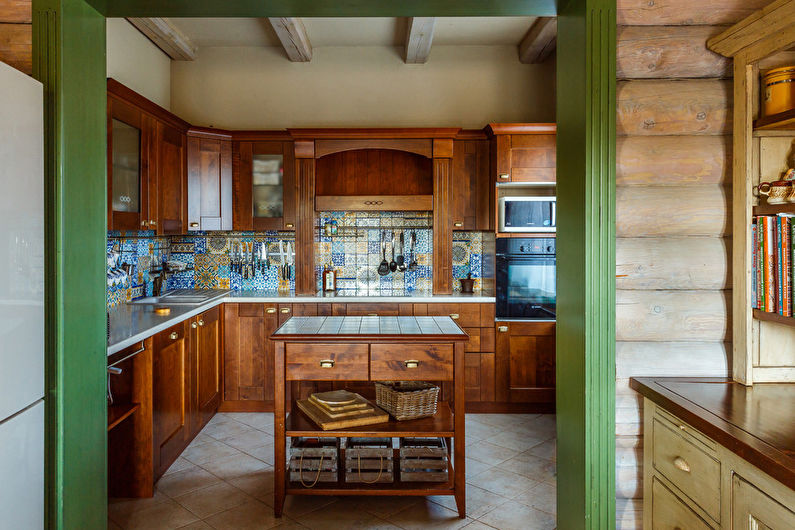
Loft Style Kitchen with Island
The deliberate simplicity of an industrial interior does not tolerate ostentation in details. In an open kitchen in this style, the island, besides its regular functions, often serves as the sole divider between the cooking area and the living space of the loft.
Modern-Style Kitchen with an Island
Hallmarks of the 21st-century kitchen include minimalism, functionality, and high technology, all designed to speed up the cooking process as much as possible. An island is an integral part of such an interior, closely matching the design of the kitchen suite.
The smooth, monochromatic countertop is made from durable composite materials like engineered stone, toughened tinted glass, or stainless steel. It can accommodate an induction hob, sink, while the cabinet body can house appliances or provide generous storage systems.
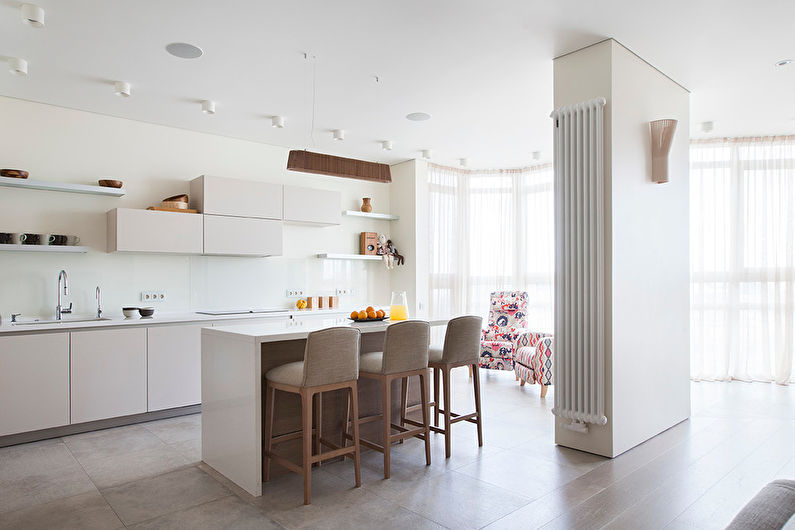
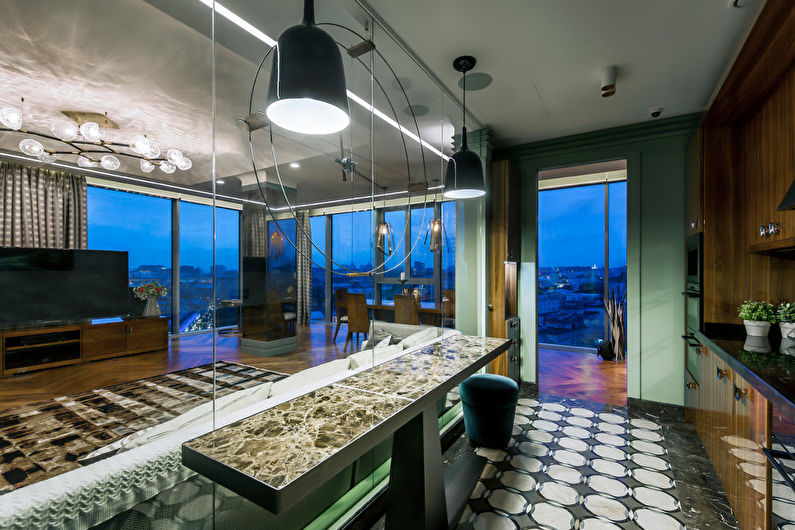
Provence-Style Kitchen with an Island
In a Provence-style kitchen, an island is as fitting as it gets. Traditionally, it is a simple wooden structure, painted in pastel shades. The color palette features creamy white, mint, turquoise, grey, blue, and lavender. The cabinet body is unadorned and free from excess decorations, but its functionality comes from the ample drawers, cabinets, shelves, and wicker baskets.
Since Southeast France is a wine-growing region, a typical kitchen island often includes diagonal honeycomb-style shelves for storing wine bottles horizontally. Countertop materials in the Provence style include light stone, marble or its artificial counterparts in white or greyish shades, but it should not be overly glossy.
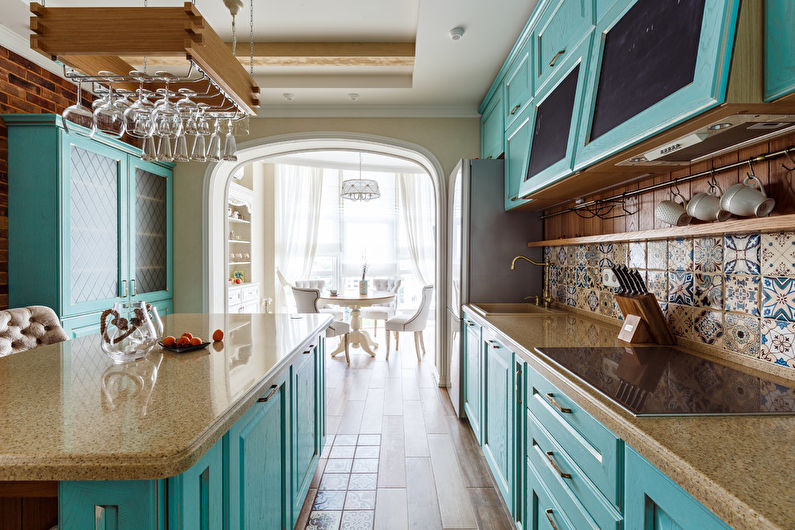
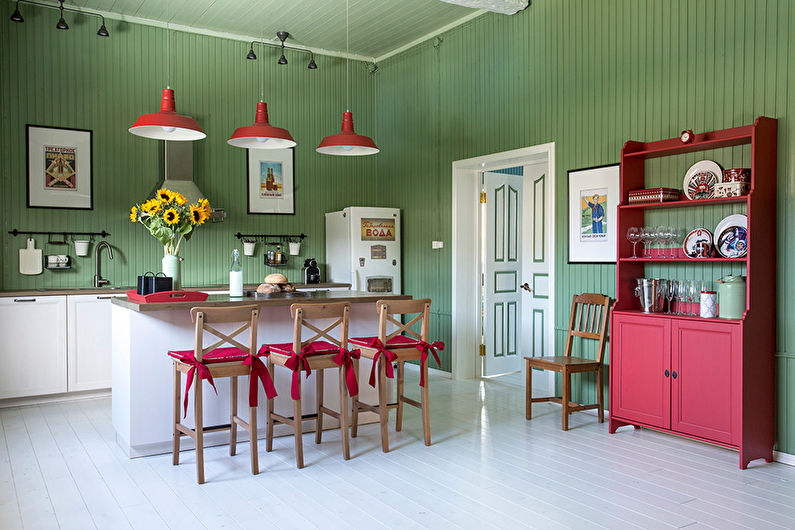
Country-Style Kitchen with an Island
Country style prioritizes natural materials and earthy tones. A sturdy, somewhat rustic cabinet made from solid wood, with large cupboard and drawer facades for storing dishes, would fit well in such an environment. Ideally, the material should be without any finish, perhaps just a protective layer of lacquer or beeswax. New furniture can be artificially aged to give it a medieval look.
Hardware should be wrought iron, as it is the main ornament and a key stylistic element in a country interior. As for the countertop, it could be of the same wood, unpolished stone, or covered with matte ceramic tiles (porcelain stoneware) in terracotta shades.
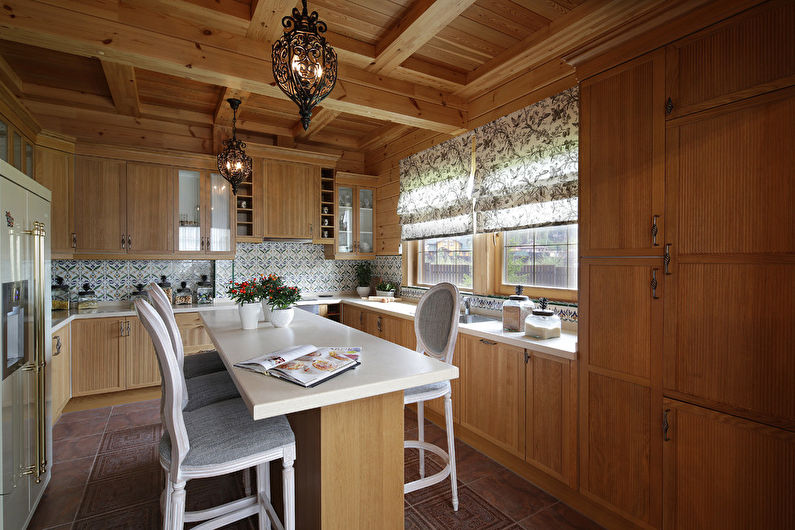

Loft-Style Kitchen with an Island
The deliberate simplicity of an industrial interior doesn’t tolerate overly ornate details. In an open-plan kitchen of this style, an island often doubles as the sole divider between the cooking zone and the loft living space.
Comparing to other design directions, here, the standalone table looks most unpretentious. Instead of a cabinet, a rough wooden, steel or stone countertop might even rest on brickwork or welded legs made from old metal pipes. Above such an improvised island, there might be open conduits with spotlight fixtures or “factory-style” lamps in black sockets.
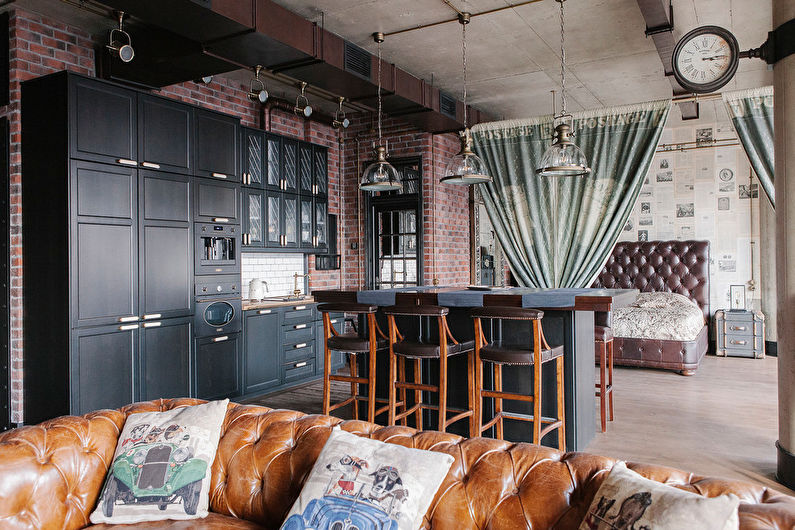
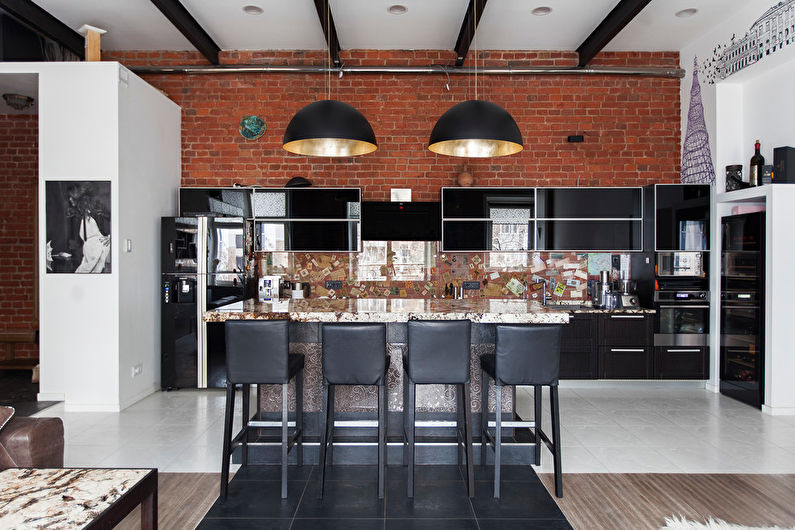
Small Kitchen with an Island: Interior Design
You might think that dreaming about a comfortable island in a small kitchen is pointless. But this common misconception only holds true for bulky classic cabinets. Modern designers have developed a plethora of mini-format models, which allow for economical and rational use of square footage.
In addition to reduced-sized stationary tables, there are also numerous movable designs. A narrow kitchen island (peninsula) can extend fully or partially from the kitchen suite; attach to the wall and unfold as needed; hide in a wall niche or under a windowsill. For occasional use, consider mobile units on wheels that you can freely move around the apartment.
In narrow kitchens with open layouts, an island often appears as a bar counter, serving both as a table and a partition. From the living room side, you could equip it with tall chairs, while in the cooking area, the design might include a lower-level fold-out countertop for convenient food preparation.
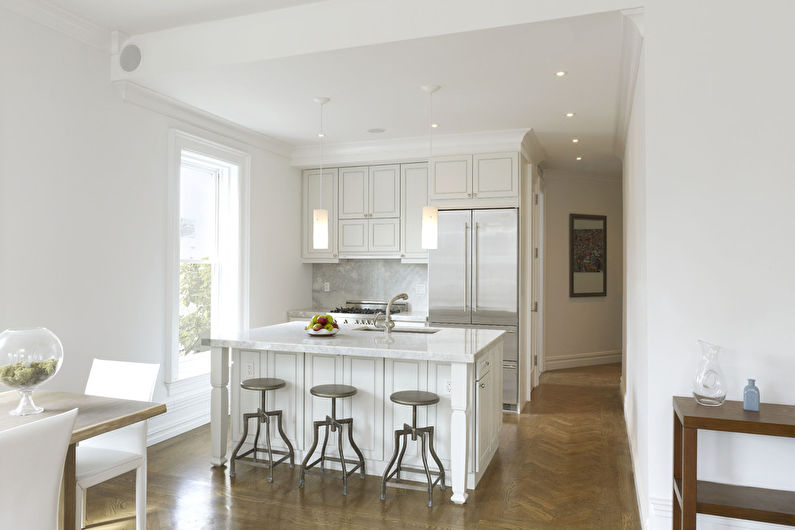
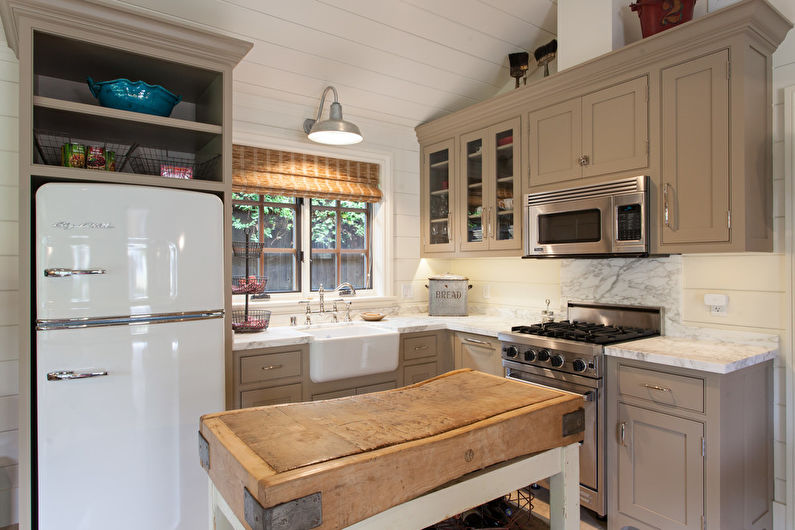
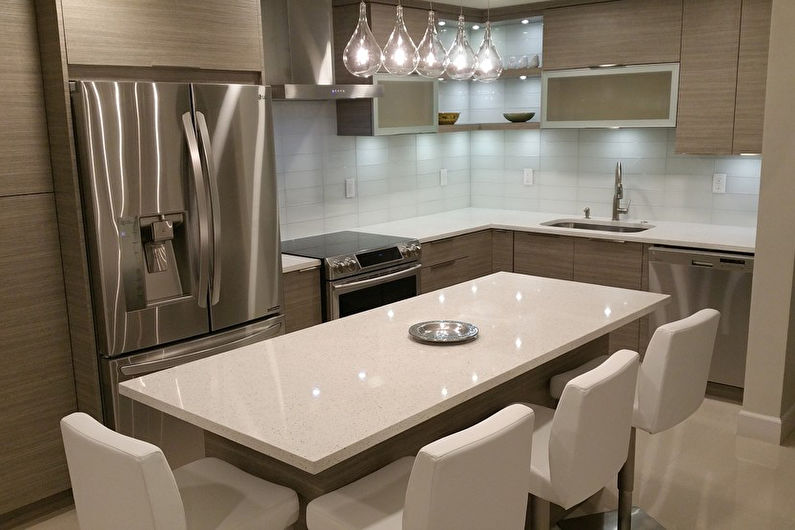
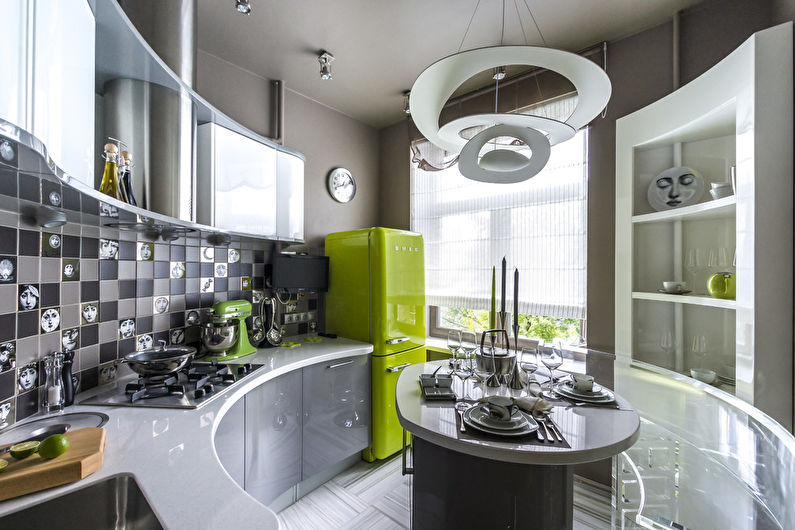
Kitchen with an Island – Photos
The best way to find a suitable design is to look at photos of how a kitchen with an island can appear in different types of rooms. For that, we invite you to explore our website’s photo gallery, where we’ve gathered an extensive collection of cooking zone design examples. Among the solutions presented, you’ll surely find great ideas suitable for both spacious private homes and apartments with small to medium-sized kitchens in various stylistic directions.
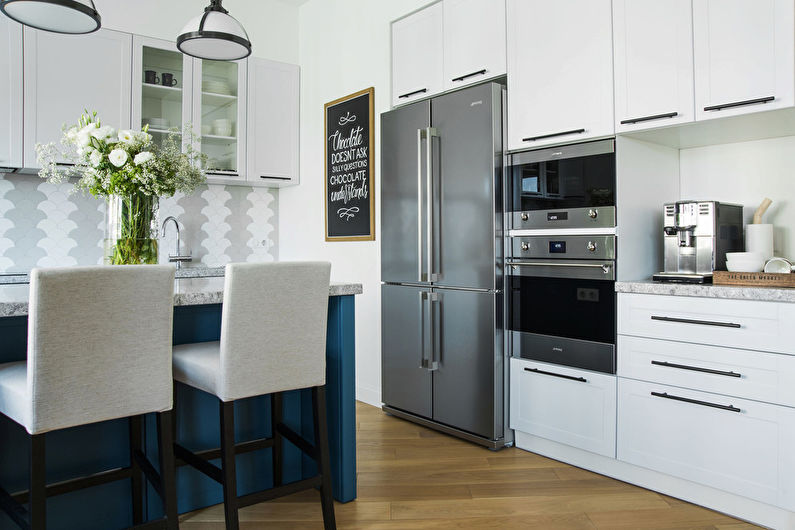
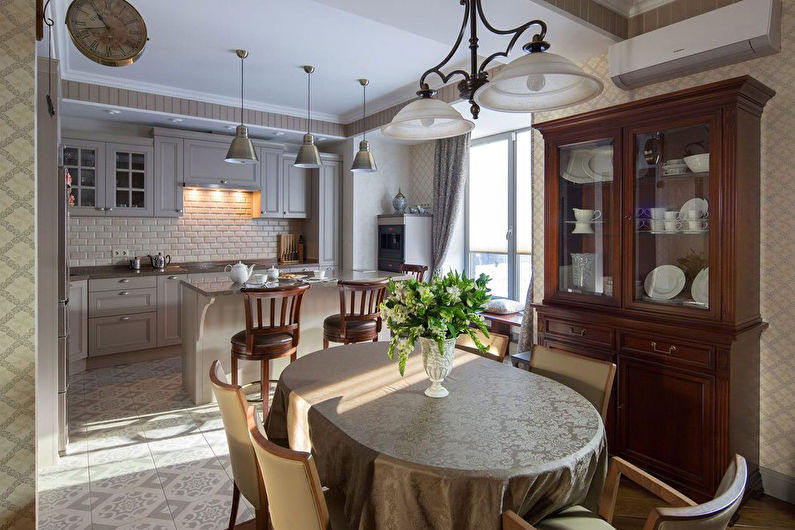
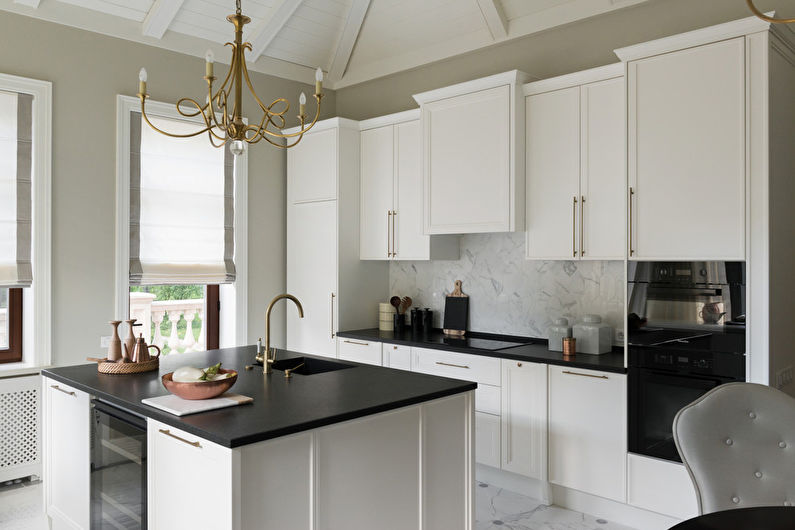
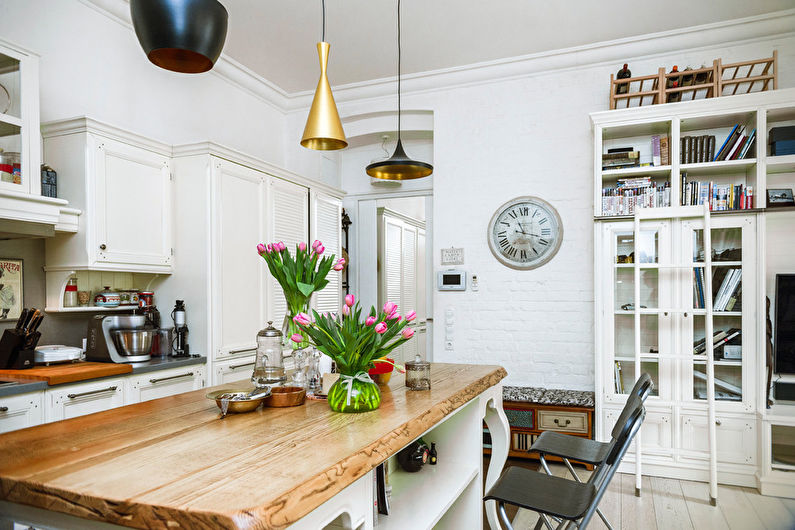
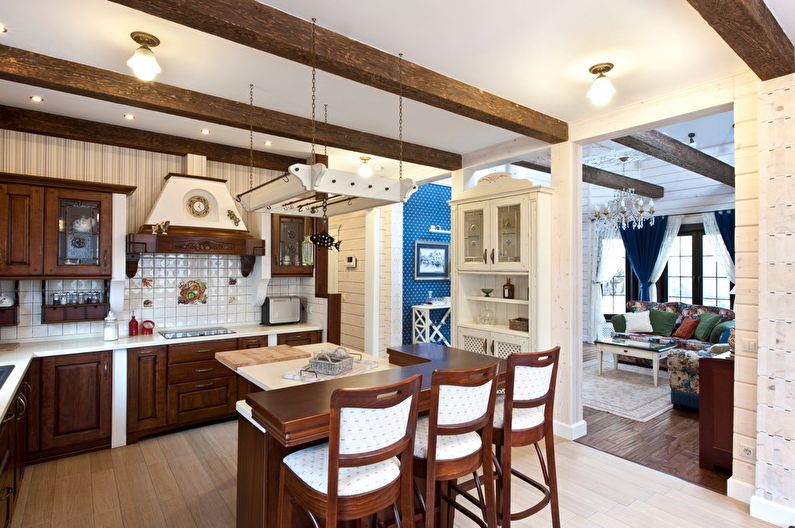
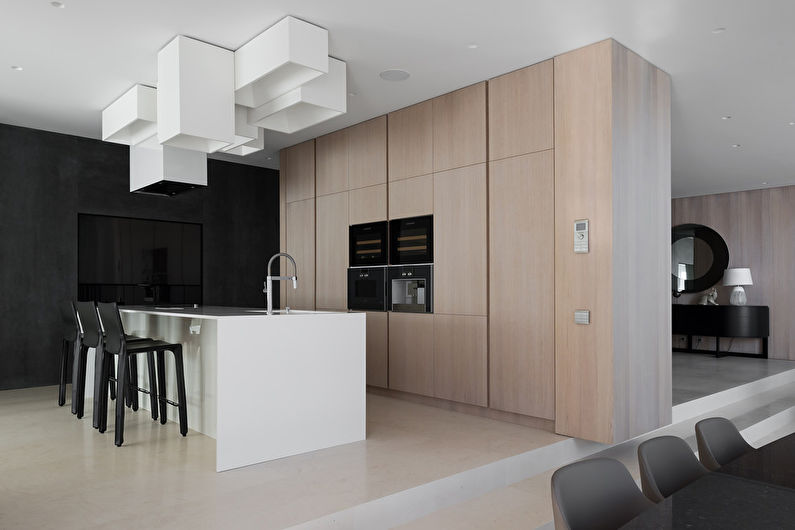
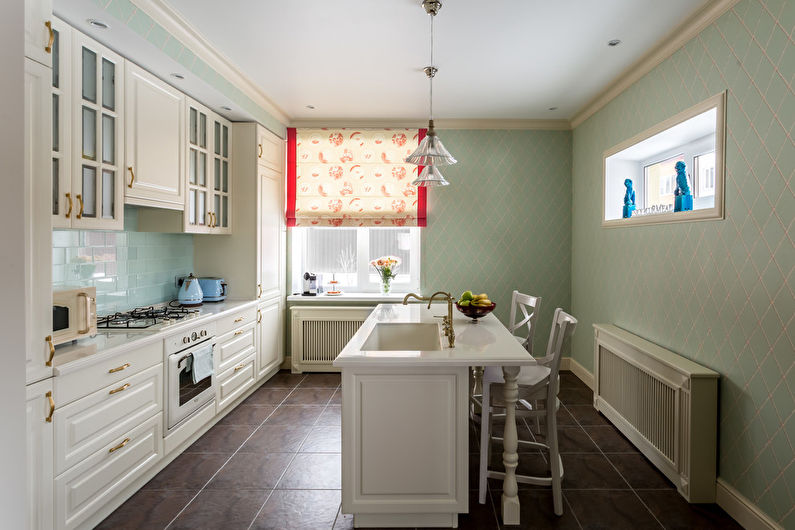
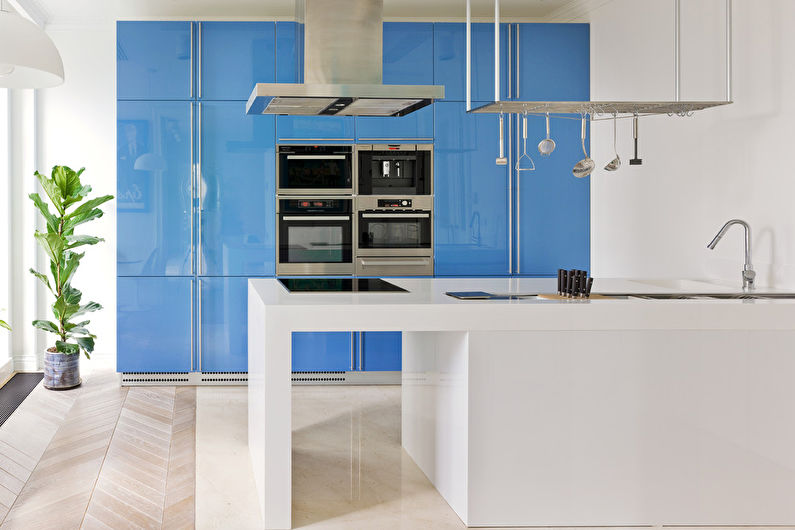
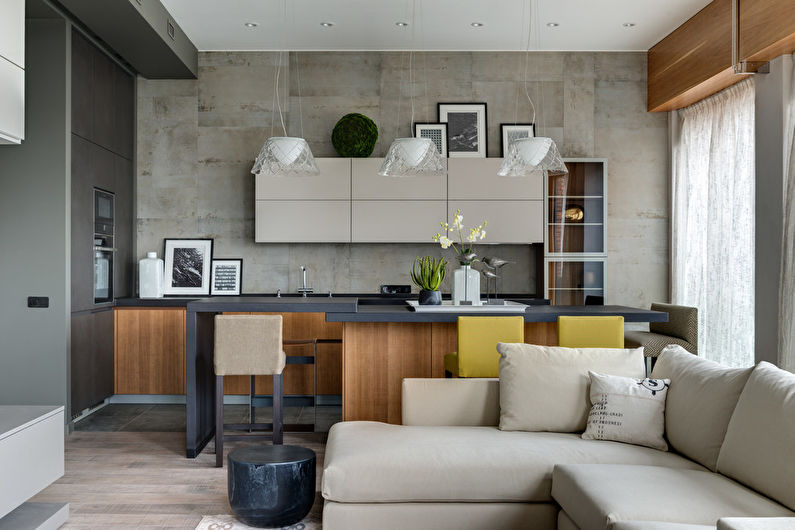
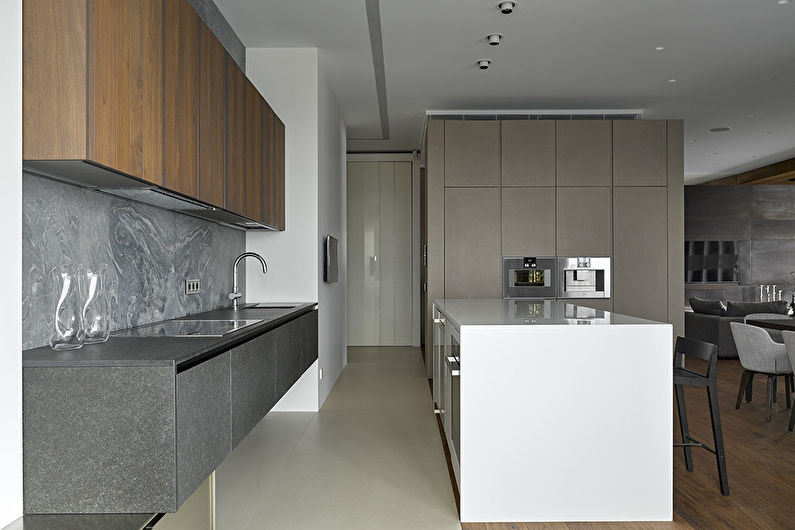

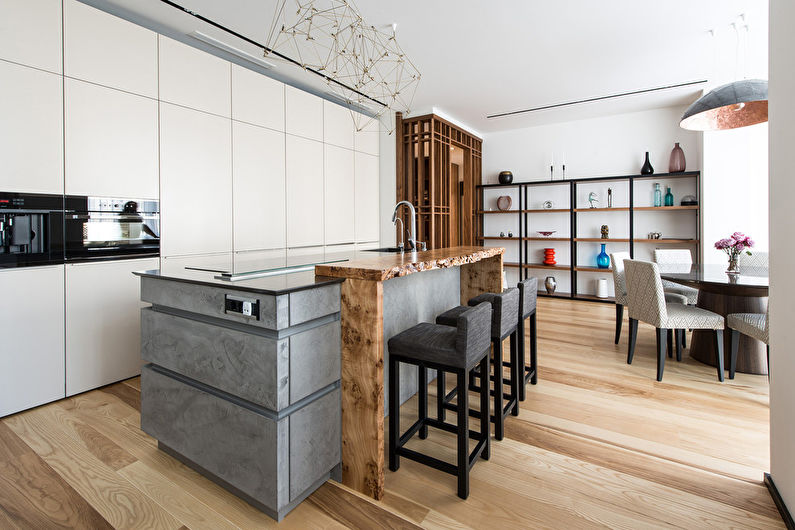
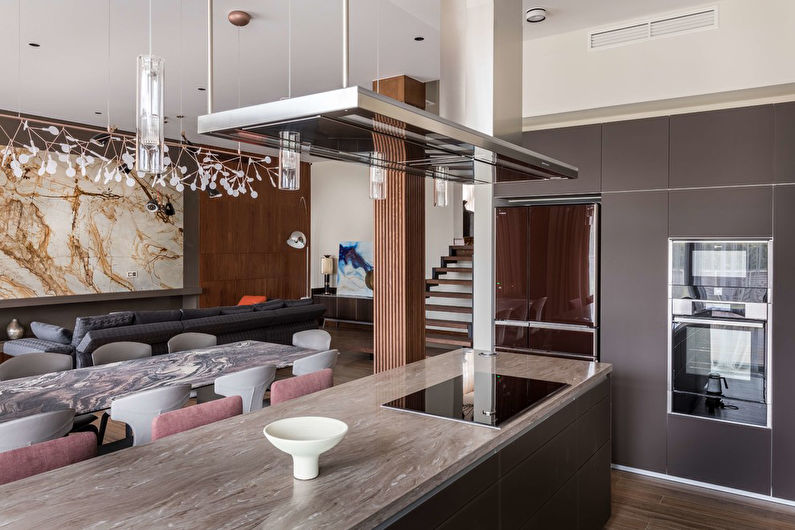
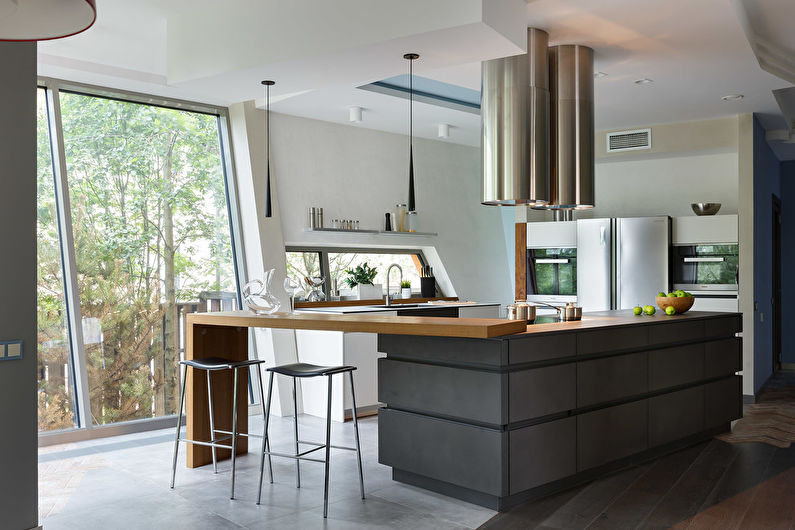
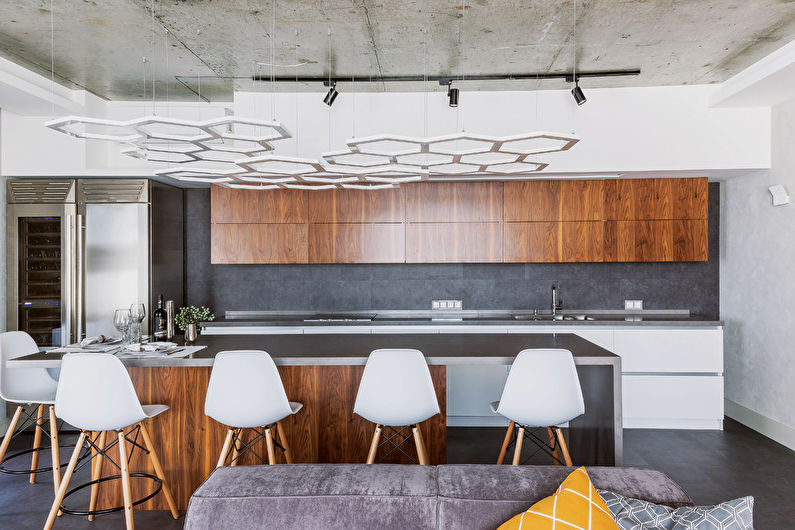

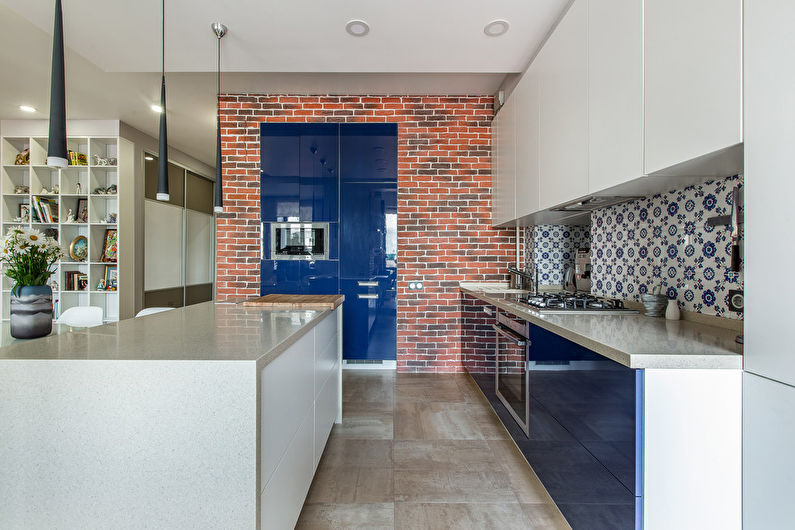


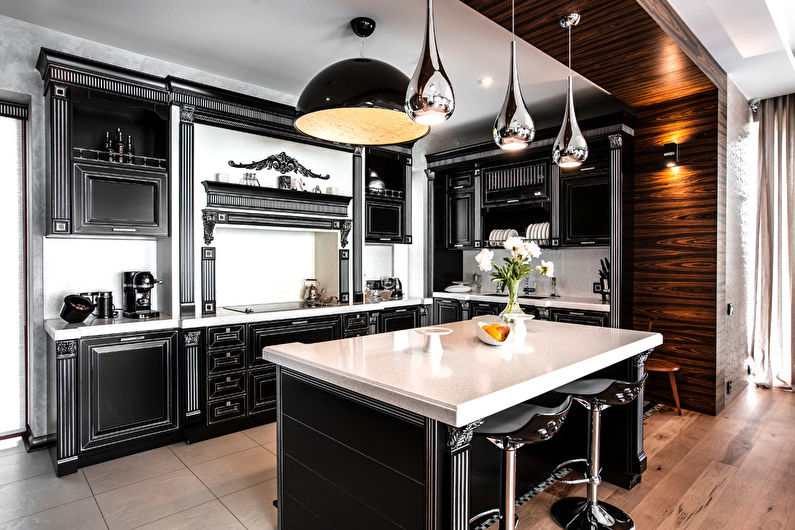
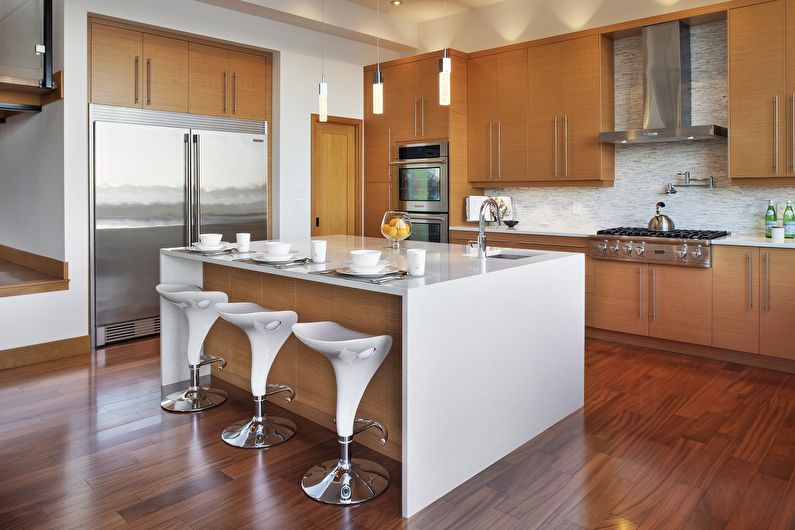
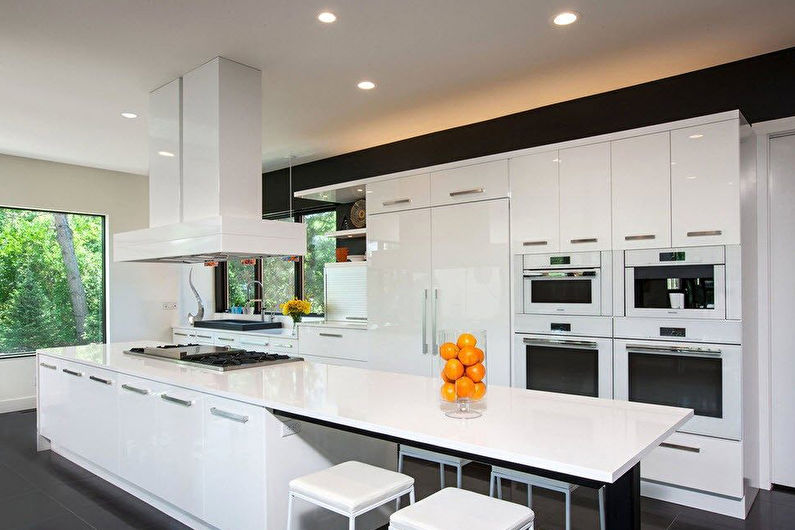
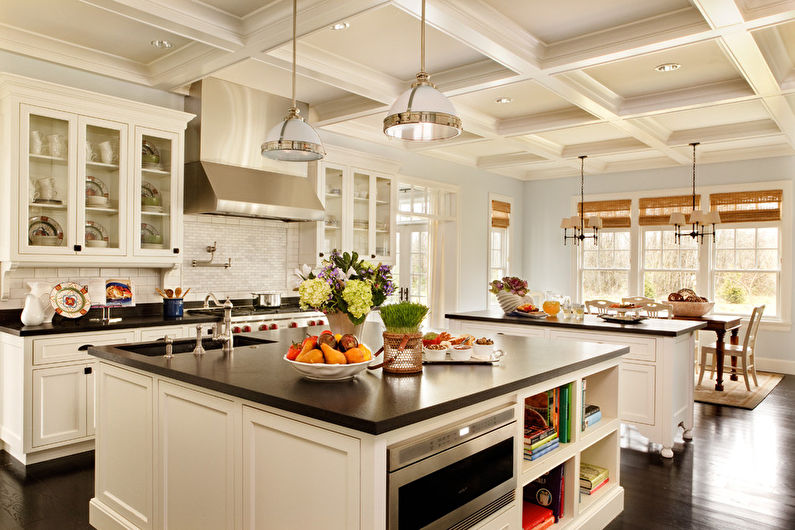
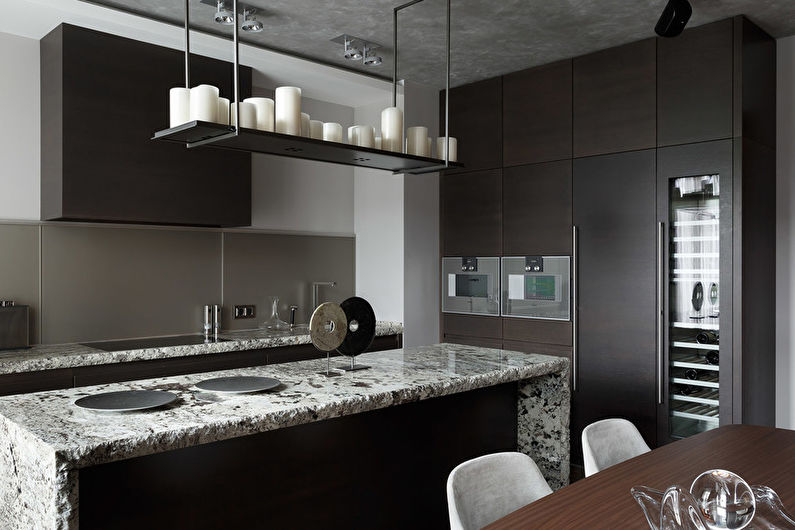
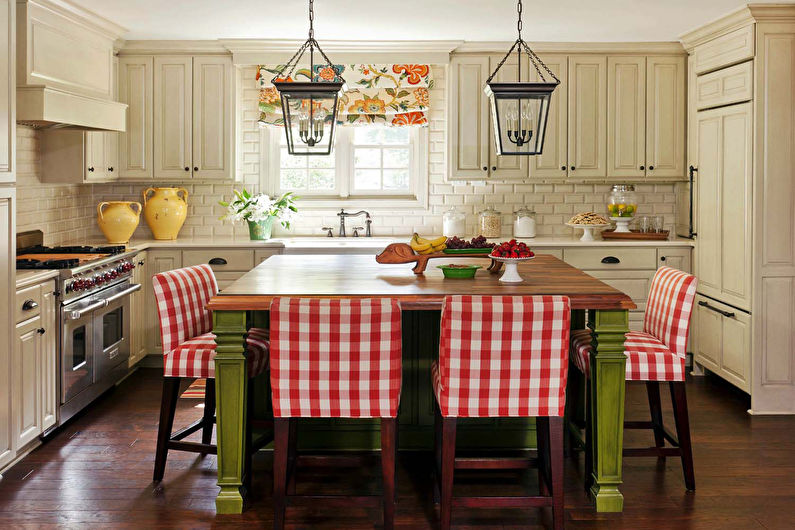
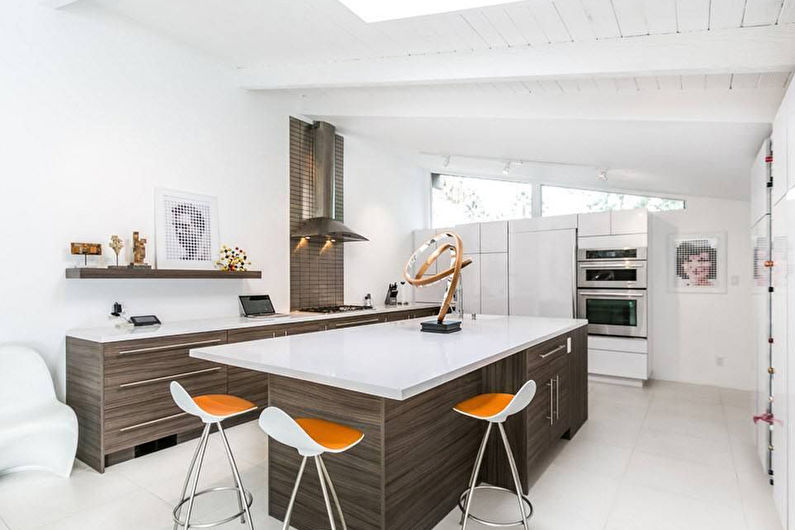
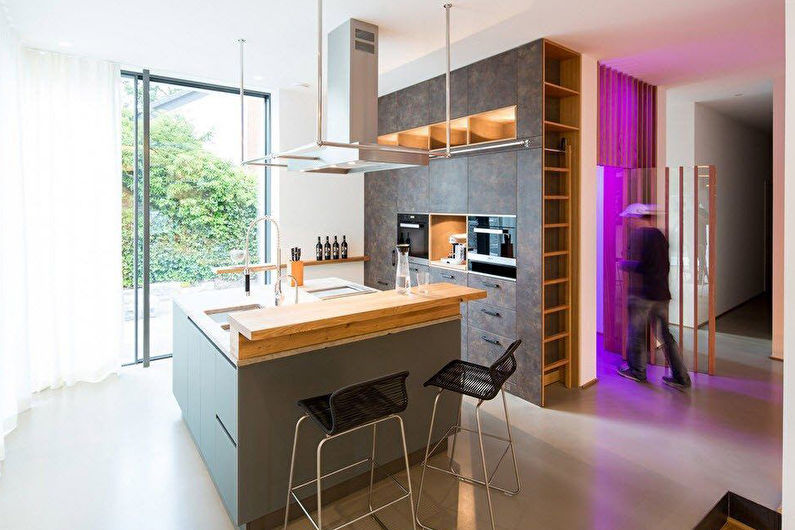
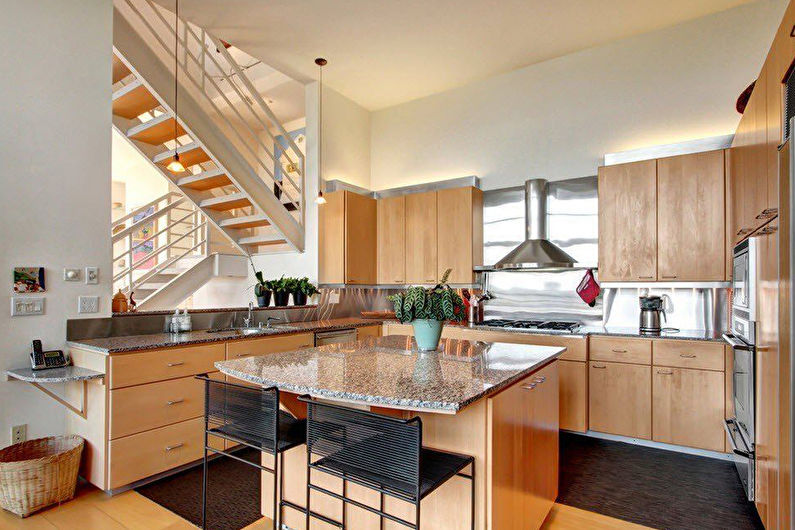
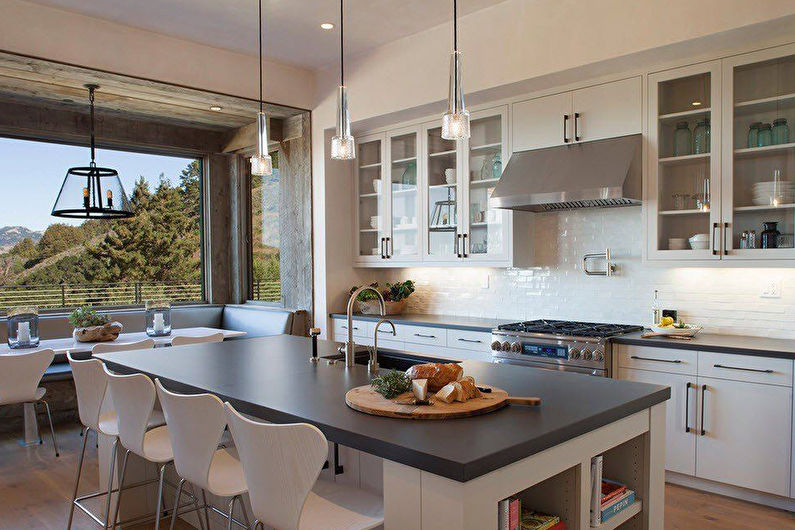
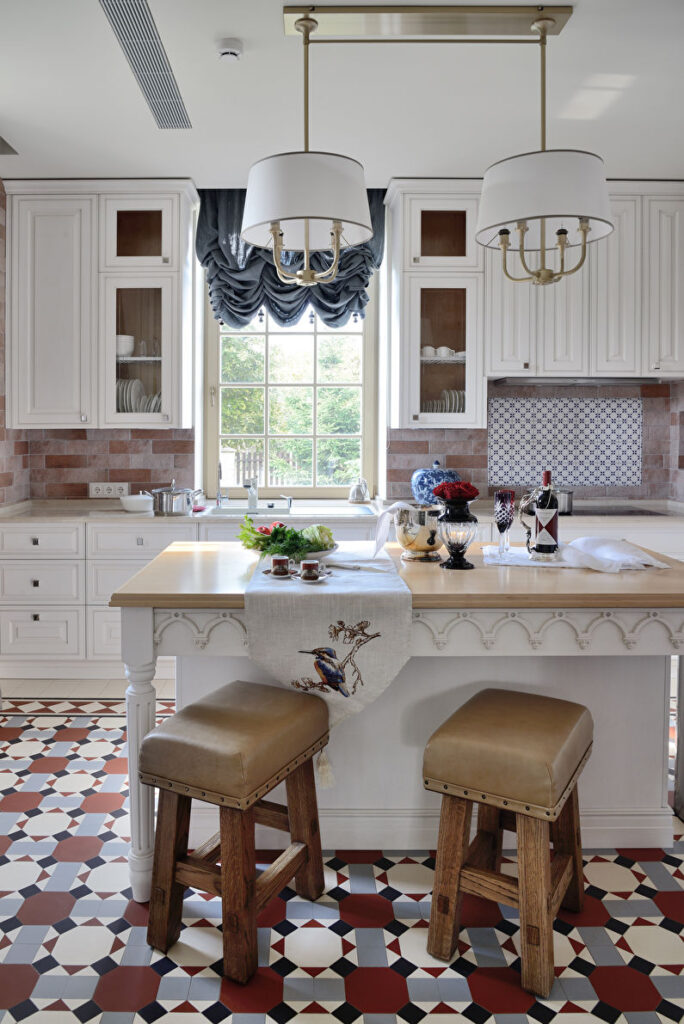
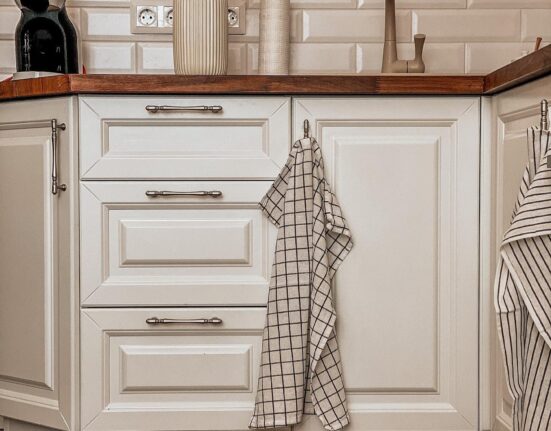

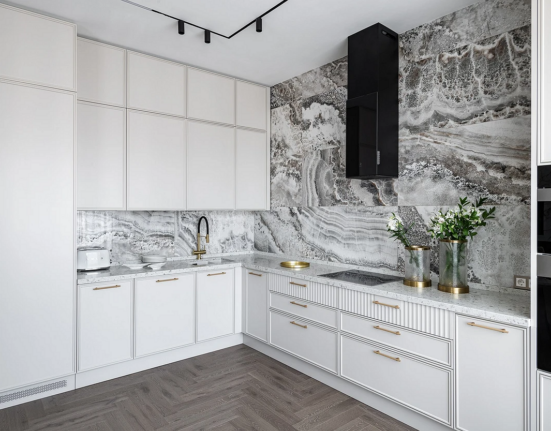
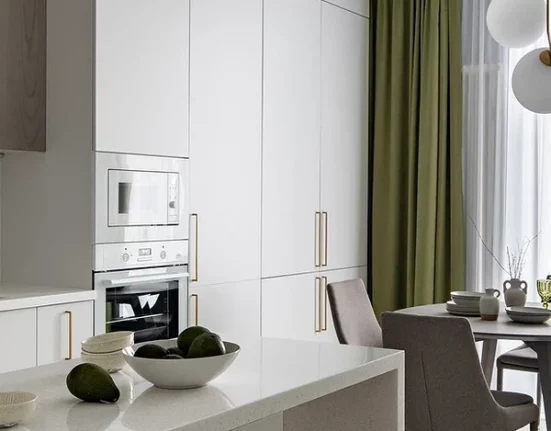
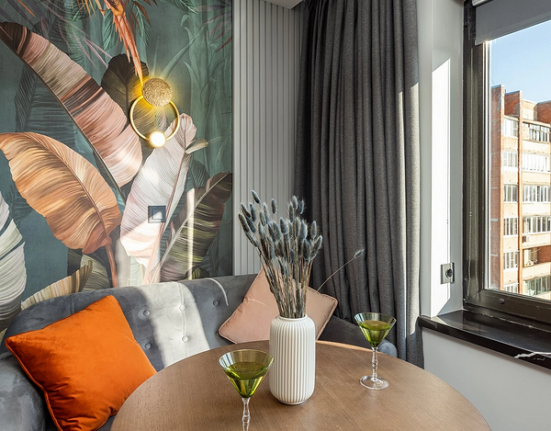
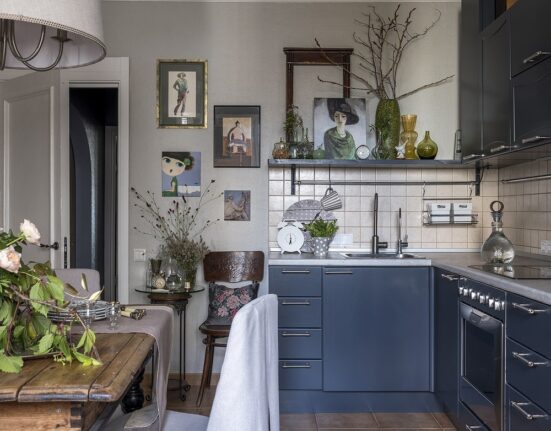
Leave feedback about this